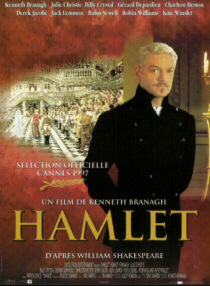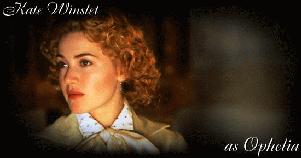HAMLET

Shakespeare of course needs no introduction. He wrote, acted and produced plays in London during the reign of England's greatest monarch -- Elizabeth -- at the turn of the 17th Century (1600). Two recent movies provide a very painless and enjoyable way to familiarize yourself with this colorful period of English history: Elizabeth starring Kate Blachard and Shakespeare in Love starring Gwynth Paltrow. Both pictures won numerous Oscars and both are still widely available in Video stores.
The great Queen died in 1603. Hamlet is first produced in London in 1604 with Richard Burbage in the title role. Hamlet is THE PLAY in the language, perhaps in the world. Every great actor since Burbage has wanted a chance to play the meloncholy prince. From our own generation ------ Christopher Walken (1982), Kevin Kline (1986), Daniel Day-Lewis (1989), Mel Gibson (1990), Ralph Fiennes (1995) and Kenneth Branagh (1997).
The Kline, Gibson and Branagh versions are readily avaiable on video for this class at retail outlets. There are also at least a half dozen other video versions available (though harder to locate), among them a John Gielgud and a Lawrence Olivier.
The two I recommend for this class are the Mel Gibson video and the Kenneth Branagh. Those totally unfamiliar with Shakespeare should elect to see the Gibson version. Though considerably cut, it captures the essence of the play, is very well acted and completely accessable to the general public. Zefferelli directs Gibson and sets the play "realistically" in Denmark in the Middle Ages, the actual time and location of Shakespeare's script.
Branagh directs himself and sets the play in what looks like a Prussian palace in the 19th Century -- 1870's or 80's. (The actual set is Blenheim Palace in England.) The costumes are therefore formal Victorian. Like Midsummer, Hamlet has been set in a variety of locations and time periods. In the 18th Century, contemporary dress was used, so Hamlet and Claudius wear knickers and wigs like Ben Franlin and Thomas Jefferson.
Both the Gibson and Branagh versions succeed. The Branagh version is better in that it conveys the total immensityof the play. Seeing 3/4 of the paintings in the Sistine Chapel is deeply satisfying, but seeing the whole chapel at once is exhiliarating beyond description. There are wonderful cameo roles by Billy Crystal, Charlton Heston, Jack Lemon, etc. The acting is excellent in both versions. The Branagh production probably comes much closer to what an Elizabethan audience would have experienced in 1604, so I recommend you give this version a try, though either is acceptable, as well as is any of the other film versions.
Of course both Gibson and Branagh are too old to play Hamlet who is supposed to be in his early twenties, but it has always been thus. By the time an actor is ready to play Hamlet, he's in his forties. Gibson looks younger than Branagh, but not by much.
Remember also that all the female parts were played by men or boys. a fact wonderfully portrayed in Shakespeare in Love. After Shakespeare's time, the Puritans closed down the theaters and when they are re-opened after the King is "re-stored" to the throne in 1660, women for the first time appear on a London stage.
Hamlet is immense in scope, so to fully enjoy the play a viewer needs to be aware of the following:
